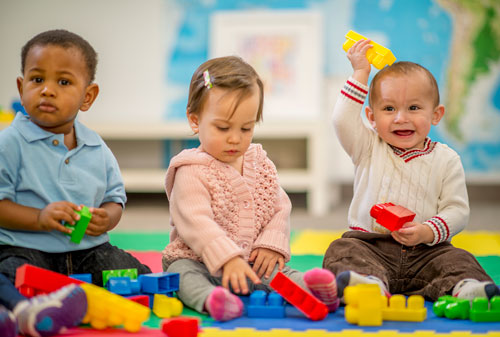




Behavioural theories are used successfully with children who have additional needs as they focus on breaking down skills into small steps, rewarding children for adhering to rules and removing privileges from the child if they do not adhere to the rules.
Albert Bandura believed that children learnt from their environment through imitation. This is called learning through observing. If a child sees an adult always speaking politely to other people, they will tend to imitate that behaviour. If a child sees another person, the model, receiving reward or praise for a specific type of behaviour, such as being polite, they will be more likely to try to imitate this. Some people will be more important to the child than others and therefore more likely to be intimidated, including an older brother, sister, parent, fellow pupil or even actors, singers or celebrities. People are more likely to imitate models of the same sex than of the opposite sex. Boys will imitate their father's male role or another male figure who they admire and girls will imitate their mother's female role or another female figure that they can relate to. If the model has great social status, power or ability, they are more likely to be imitated, for example, pop stars and other celebrities or actors in soap operas. Bandura believed that children imitate 'good' and 'bad' behaviour. In his well-known experiment using a Bobo doll, children who observed an adult behaving aggressively towards the plastic doll imitated the aggressive behaviour.
See:
Skinner suggested that behaviour can be reinforced and that children can learn as a result of their actions. He referred to this as 'operant conditioning'. The reinforcement may be positive, such as a pleasant outcome, praise for example, or negative, such as an unpleasant outcome, a punishment for example. Children can be rewarded or praised for saying their first word, so may repeat that or older children could be punished for swearing and therefore would be less likely to do so again.
Pavlov's classical conditioning theory looks at how children can be conditioned to behave in a certain way and can learn behaviour. Children learn how to connect different behaviours with different responses. If a child gets attention for an action or for speaking in a certain way, and that the response is pleasant, they are likely to repeat the behaviour. If the response is negative, they are unlikely to repeat the behaviour. For example, a child may know that crying draws the attention of their parents, and will therefore repeat the action
Watson believed that children have three basic emotional reactions:
He suggested that new emotional reactions could be conditioned and that these would develop over time. He also emphasised the importance of learning and environmental influences within human development.
Piaget believed that intelligence is established at birth and that children make an active attempt to understand the world around them. He believed that children learnt best by discovering things for themselves, learning through experience and developing what he referred to as 'schemas' to make sense of the world around them. Piaget believed that children moved through four stages of cognitive development:
Glasser’s theory states that an individual’s behaviour depends on their needs at a given time and that they then control their behaviour to meet their needs. The individual can change their quality of life depending on the choices they make. It is person-centred and highlights the importance of giving the individual choices and responsibility.
This is a theory of assertive discipline which states that staff and pupils should have the right to learn and be taught in a quiet environment free from harassment or misbehaviour. Staff need to be assertive in managing behaviour to ensure that no pupil interrupts or disrupts the lesson. Staff raise pupils' awareness of the consequences of their behaviour whether positive or negative.
Mae damcaniaethau ymddygiad yn cael eu defnyddio’n llwyddiannus gyda phlant ag anghenion ychwanegol gan eu bod yn canolbwyntio ar dorri sgiliau i lawr i gamau bychain, gan wobrwyo plant am gadw at reolau a thynnu breintiau oddi ar y plentyn os nad yw’n cadw at y rheolau.
Credai Albert Bandura fod plant yn dysgu o’u hamgylchedd drwy ddynwared. Yr enw ar hyn yw dysgu drwy arsylwi. Os bydd plentyn yn gweld oedolyn yn sgwrsio’n gwrtais â phobl eraill bob amser, bydd yn tueddu i ddynwared yr ymddygiad hwnnw. Os bydd plentyn yn gweld person arall, y model, yn cael gwobr neu ganmoliaeth am fath penodol o ymddygiad, megis bod yn gwrtais, bydd yn fwy tebygol o geisio ei ddynwared. Bydd pobl wedyn yn ffurfio barn ynghylch sut i ymddwyn mewn sefyllfaoedd tebyg eraill. Bydd rhai pobl yn fwy pwysig i’r plentyn nag eraill ac felly’n fwy tebygol o gael eu dynwared, gan gynnwys brawd neu chwaer hŷn neu riant, cyd-ddisgybl, neu hyd yn oed actorion, cantorion neu enwogion. Mae pobl yn fwy tebygol o ddynwared modelau o’r un rhyw â nhw na rhai o’r rhyw arall. Bydd bechgyn yn dynwared rôl wrywaidd eu tad neu ffigwr gwrywaidd arall maen nhw’n ei edmygu a bydd merched yn dynwared rôl fenywaidd eu mam neu fodel benywaidd arall maen nhw’n uniaethu â hi. Os yw’r model yn meddu statws cymdeithasol, pŵer, neu allu mawr, mae’n fwy tebygol o gael ei dynwared, er enghraifft, sêr canu pop ac enwogion eraill neu actorion mewn operâu sebon. Credai Bandura fod plant yn dynwared ymddygiad ‘da’ a ‘drwg’. Yn ei arbrawf enwog wrth ddefnyddio dol Bobo, roedd plant a oedd wedi arsylwi oedolyn yn ymddwyn yn ymosodol tuag at ddol blastig yn dynwared yr ymddygiad ymosodol.
Gwyliwch y fideo isod i er mwyn dysgu mwy am arbrawf Bandura:
Awgrymodd Skinner y gellir atgyfnerthu ymddygiad ac y gall plant ddysgu drwy ganlyniadau eu gweithredoedd. Galwodd hyn yn ‘gyflyru gweithredol’. Gall yr atgyfnerthu fod yn gadarnhaol, sef canlyniad pleserus, fel canmoliaeth, neu’n negyddol, sef canlyniad annifyr, fel cosb. Cyfeiriodd at ymddygiadaeth wrth sôn am iaith gan ddweud fod plant yn dysgu iaith drwy gael eu gwobrwyo. Gall plant gael eu gwobrwyo neu eu canmol am ddweud eu gair cyntaf megis ‘ma-ma-ma’ ond ni fyddant yn cael eu canmol am wneud synau annealladwy. Bydd plant hŷn yn cael eu cosbi am regi ac felly’n llai tebygol o wneud hynny eto.
Mae damcaniaeth cyflyru clasurol Pavlov yn edrych ar sut gall plant gael eu cyflyru i ymddwyn mewn ffordd arbennig a dysgu ymddygiad. Mae plant yn dysgu sut i gysylltu gwahanol ymddygiadau gyda gwahanol ymatebion. Os yw plentyn yn cael sylw am weithred neu am siarad mewn ffordd arbennig, ac mae’r ymateb mae’n derbyn yn ddymunol, mae’n debygol o ail-wneud yr ymddygiad. Os yw’r ymateb yn negyddol yna mae’n annhebygol o ail-wneud yr ymddygiad. Er enghraifft, gall plentyn wybod bod crio’n tynnu sylw ei rieni, ac felly bydd yn ail-wneud hynny.
Credai Watson fod gan blant dri adwaith emosiynol sylfaenol:
Awgrymodd y gellid cyflyru adweithiau emosiynol newydd ac y byddai’r rhain yn datblygu gydag amser. Pwysleisiodd hefyd bwysigrwydd dysgu a dylanwadau amgylcheddol mewn datblygiad dynol.
Er mai damcaniaeth adeileddol a gwybyddol yw damcaniaeth Piaget bydd gallu’r plentyn i symud drwy’r camau yn effeithio ar ei ymddygiad. Credai Piaget fod deallusrwydd yn cael ei sefydlogi ar enedigaeth a bod plant yn ymdrechu’n weithredol i ddeall y byd maen nhw’n byw ynddo. Credai bod plant yn dysgu orau wrth ddarganfod pethau drostyn nhw eu hunain, ‘dysgu trwy brofiad’ ac yn datblygu’r hyn a alwai’n ‘sgemâu’ i wneud synnwyr o’r byd o’u cwmpas. Credai Piaget bod plant yn symud drwy bedwar cyfnod mewn datblygiad gwybyddol:
Mae damcaniaeth Glasser yn nodi bod ymddygiad unigolyn yn dibynnu ar ei anghenion ar adeg benodol a’i fod wedyn yn rheoli ei ymddygiad i gwrdd â’i anghenion. Gall yr unigolyn newid ansawdd ei fywyd yn ddibynnol ar y dewisiadau mae’n gwneud. Mae’n canolbwyntio ar yr unigolyn gan nodi pwysigrwydd rhoi dewisiadau a chyfrifoldeb i’r unigolyn.
Damcaniaeth sy’n trafod disgyblaeth bendant sydd yn nodi y dylai fod gan staff a disgyblion yr hawl i ddysgu a chael eu dysgu mewn amgylchedd tawel heb fod unrhyw aflonyddwch neu gamymddwyn. Mae angen i staff fod yn bendant wrth reoli ymddygiad fel nad oes yr un disgybl yn torri ar draws ac yn amharu ar y wers. Bydd staff yn codi ymwybyddiaeth disgyblion am ganlyniadau eu hymddygiad boed yn bositif neu’n negyddol.
Hint 1: Lorem ipsum dolor sit amet, consectetur adipisicing elit. Modi est praesentium earum exercitationem, accusantium molestiae asperiores reiciendis aliquam doloribus, delectus, cumque odio omnis rem, aliquid et. Quisquam eius, incidunt ab.
Awgrymiadau 1: Lorem ipsum dolor sit amet, consectetur adipisicing elit. Modi est praesentium earum exercitationem, accusantium molestiae asperiores reiciendis aliquam doloribus, delectus, cumque odio omnis rem, aliquid et. Quisquam eius, incidunt ab.

Exhibiting challenging behavior means that an individual behaves in a way that prevents them from interacting with others in society. Such behaviour can cause harm to the individual and others and affect their lives.
1 in 8 people with additional needs exhibit behaviour which challenges that can lead to injuries and disruption within the family, and that negatively affects education and employment.
Behaviour which challenges may include:
Behaviour which challenges can be caused by a number of factors such as:
Mae arddangos ymddygiad heriol yn golygu bod unigolyn yn ymddwyn mewn ffordd sydd yn ei atal rhag ymwneud gydag eraill o fewn cymdeithas. Gall ymddygiad o’r fath achosi niwed i’r unigolyn ac i eraill gan effeithio eu bywydau.
Mae 1 person mewn 8 sydd ag anghenion ychwanegol yn arddangos ymddygiad heriol sy’n gallu arwain at anafiadau, aflonyddwch o fewn y teulu, gan effeithio’n negyddol ar addysg a chyflogaeth.
Gall ymddygiad heriol gynnwys ymddygiad sy’n:
Gall nifer o ffactorau arwain at ymddygiad heriol gan blant megis:
Hint 2: Lorem ipsum dolor sit amet, consectetur adipisicing elit. Modi est praesentium earum exercitationem, accusantium molestiae asperiores reiciendis aliquam doloribus, delectus, cumque odio omnis rem, aliquid et. Quisquam eius, incidunt ab.
Awgrymiadau 2: Lorem ipsum dolor sit amet, consectetur adipisicing elit. Modi est praesentium earum exercitationem, accusantium molestiae asperiores reiciendis aliquam doloribus, delectus, cumque odio omnis rem, aliquid et. Quisquam eius, incidunt ab.

If a child exhibits behaviour which challenges, it is important that practitioners are aware of a range of initial prevention and early intervention strategies that can be used to support positive behaviour. It will be necessary to work in a way that embeds these strategies into their daily work.
If children are given a set of clear rules to follow, they will understand what is expected of them. The boundaries need to be clear so that children understand what they can and cannot do, and if the rules and boundaries change then behaviour management becomes more difficult.
Children should be included in the discussion when setting rules and boundaries and they will be more likely to adhere to them as they understand their purpose better. Care must be taken not to place expectations that are too high on children to ensure that they do not fail to meet them. This can make them feel worthless which in turn will disrupt behaviour. Expectations that are too low can lead to boredom among children.
The environment can influence the way children behave. A noisy environment can impair the child's ability to listen and concentrate. If the room is too cold or too hot, children's mood will change and they will not achieve their full potential. It is necessary to adhere to regular times when arranging a daily programme within childcare settings. When arranging regular daily eating, playing and sleeping times, children will develop and become familiar with the routine and understand its importance. An environment which is stimulating for the age and stage of developmental stage of the child is also necessary. By keeping children happy, they are more likely to exhibit positive behaviour.
By taking children's interests and likes and dislikes into account, the practitioner can plan positively for them. Children will respect the practitioner's interest in them. Children need access to daily activities, experiences and routines that engage them as well as being meaningful and enjoyable. Children learn through their play without the help of the adult, but sometimes, the practitioner's input is needed to ensure that the environment is rich and offers many possibilities. This is the practitioner's duty and it can be achieved by responding to the children's needs, balancing risk and challenge, building positive relationships and promoting independence skills.
The rewards and punishments must be consistent so that children understand the consequences of their behaviour. Rewarding a child for exhibiting positive behaviour reinforces that behaviour. The child therefore receives a message that this behaviour needs to happen again and they will be more likely to repeat the behaviour if rewarded. For this approach to prove effective, rewards need to be something that children are eager to receive. The rewards can be in the form of a star chart or children being given extra time to do what interests them. They can also be a certificate, a lucky dip, a sticker or permission to phone home. Sometimes reinforcements may need to be adapted to the needs of some children. A child may not be interested in the star chart and will prefer to spend time in the outdoor area as a reward.
It is important to support children as they undertake tasks and activities so that they can develop confidence to undertake activities themselves. The practitioner must develop an understanding of the child's needs in order to adequately support them and avoid undermining their confidence. By giving constant praise, the child will feel good and will be more willing to try more challenging things. Children like to be praised and therefore they act positively for this to happen. Children should be praised for their efforts rather than what they achieve. Children could be encouraged to praise each other by clapping or shouting when someone is doing something positive. This will create a fun-filled environment and one that promotes positive behaviour. It is important not to give praise unless there is a specific reason for doing so. It is necessary to decide which behaviour needs to be encouraged, and which behaviour is unacceptable.
Sometimes a child may feel pressured to achieve when undertaking activities within the setting. In this situation, it is important not to put too much stress on the child. The child's enjoyment and the process of learning are far more valuable than the end product. As the child develops an understanding of this, they will feel less anxiety and distress and improve their behaviour.
If the child is concerned about something, it is important that the practitioner is there and ready to listen. Sometimes anxiety can lead to behaviour which challenges that will affect the child's desire to try new things in case they fail.
Resilience is the ability to deal with stress, failure, challenges or trauma and it is a skill that children develop as they grow. Resilience can help children manage feelings of anxiety and uncertainty and it helps them to take healthy risks because they are not afraid of failure. Resilient children have learnt to persevere after mistakes or failure. They know their limits and this helps them reach their goals and solve problems independently. Listening to children increases their resilience and demonstrates that what they have to say is important. By feeling that their voice is being heard, children will develop communication and intellectual skills and manage their feelings and behaviour better.
Os yw plentyn yn arddangos ymddygiad heriol mae’n bwysig bod ymarferwyr yn ymwybodol o amrywiaeth o strategaethau ataliad cychwynnol ac ymyrraeth gynnar y gellir eu defnyddio i gefnogi ymddygiad cadarnhaol. Bydd angen gweithio mewn ffordd sy’n mewnblannu’r strategaethau hyn i’w gwaith pob dydd.
Os yw plant yn derbyn cyfres o reolau clir i’w dilyn byddant yn deall beth sydd i’w ddisgwyl ganddynt. Mae angen i’r ffiniau fod yn glir fel bod plant yn deall beth allant wneud a’r hyn na allant wneud ac os yw’r rheolau a’r ffiniau yn newid yna bydd rheoli ymddygiad yn anoddach.
Dylid cynnwys plant yn y drafodaeth wrth osod rheolau a ffiniau byddant yn fwy tebygol o gael eu cadw gan fod y plant yn deall eu pwrpas yn well. Rhaid gofalu na osodir disgwyliadau rhy uchel ar blant rhag iddynt fethu eu cyflawni. Gall hyn wneud iddynt deimlo’n ddiwerth a fydd yn ei dro yn amharu ar ymddygiad. Gall disgwyliadau rhy isel arwain at ddiflastod ymysg y plant.
Mae’r amgylchedd yn gallu llywio sut mae plant yn ymddwyn. Gall amgylchedd swnllyd amharu ar allu’r plentyn i wrando a chanolbwyntio. Os yw’r ystafell yn rhy oer neu’n rhy boeth yna bydd hwyliau’r plant yn newid ac ni fyddant yn cyflawni i’r eithaf. Mae angen cadw at amseroedd cyson wrth drefnu rhaglen ddyddiol o fewn lleoliadau gofal plant. Wrth drefnu amseroedd bwyta, chwarae a chysgu cyson bob dydd, bydd plant yn datblygu ac yn arfer gyda’r drefn gan ddeall ei bwysigrwydd. Mae hefyd angen amgylchedd sy’n cynnig symbyliad addas ar gyfer oed a cham datblygiad y plentyn. Wrth gadw plant yn hapus maent yn fwy tebygol o arddangos ymddygiad cadarnhaol.
Trwy gymryd i ystyriaeth ddiddordebau’r plant a beth yw eu hoff bethau a’u cas bethau, gall yr ymarferwr gynllunio’n gadarnhaol ar eu cyfer. Bydd plant yn parchu bod gan yr ymarferwr ddiddordeb ynddynt. Rhaid i blant gael mynediad at weithgareddau, profiadau ac arferion dyddiol sy’n ennyn eu diddordeb yn ogystal â bod yn ystyrlon a phleserus. Bydd plant yn dysgu trwy eu chwarae heb gymorth yr oedolyn ond weithiau bydd angen mewnbwn yr ymarferwr er mwyn sicrhau bod yr amgylchedd yn gyfoethog ac yn un sy’n cynnig llawer o bosibiliadau iddynt. Dyma yw dyletswydd yr ymarferwr a gellir cyflawni hyn trwy ymateb i anghenion y plant, cydbwyso risg a her, meithrin cydberthnasau cadarnhaol a hybu sgiliau annibyniaeth.
Mae’r rhaid bod cysondeb o ran y gwobrwyon a’r cosbau fel bod plant yn deall canlyniadau eu hymddygiad. Wrth wobrwyo plentyn am ddangos ymddygiad cadarnhaol mae’r ymddygiad hwnnw’n cael ei atgyfnerthu. Mae’r plentyn felly yn derbyn neges bod angen i’r ymddygiad hwn ddigwydd eto a bydd yn fwy tebygol o ailadrodd yr ymddygiad os caiff ei wobrwyo. Er mwyn i’r dull yma brofi’n effeithiol, mae angen i wobrau fod yn rhywbeth y mae plant yn awyddus i’w derbyn. Gall y gwobrwyo fod ar ffurf siart seren neu roi amser ychwanegol i blant wneud yr hyn sydd o ddiddordeb iddynt. Gall hefyd fod yn dystysgrif, yn dwba lwcus, sticer neu ganiatâd i ffonio adref. Weithiau bydd angen addasu atgyfnerthiadau ar gyfer anghenion rhai plant. Efallai na fydd gan blentyn ddiddordeb yn y siart seren ac fe fydd well ganddo dreulio amser yn yr ardal allanol fel gwobr.
Mae’n bwysig cefnogi plant wrth iddynt ymgymryd â thasgau a gweithgareddau fel y gallant ddatblygu’r hyder i ymgymryd â gweithgareddau eu hunain. Rhaid i’r ymarferwr ddod i ddeall anghenion y plentyn er mwyn eu cefnogi’n ddigonol a pheidio tanseilio eu hyder. Trwy roi canmoliaeth gyson bydd y plentyn yn teimlo’n dda ac yn fwy parod i roi cynnig ar bethau mwy heriol. Mae plant yn hoffi derbyn canmoliaeth ac felly yn ymddwyn yn gadarnhaol er mwyn i hyn ddigwydd. Dylid canmol plant am eu hymdrechion yn hytrach na’r hyn sy’n cael ei gyflawni ganddynt. Gellid annog plant i ganmol ei gilydd trwy glapio neu floeddio pan fydd rhywun yn gwneud rhywbeth cadarnhaol. Bydd hyn yn creu amgylchedd sy’n llawn hwyl ac un sy’n hyrwyddo ymddygiad cadarnhaol. Mae’n bwysig peidio rhoi canmoliaeth os nad oes yna reswm penodol am wneud hynny. Rhaid penderfynu pa ymddygiad sydd angen ei annog, a pha ymddygiad sy’n annerbyniol.
Weithiau bydd plentyn yn teimlo dan bwysau i gyflawni wrth ymgymryd â gweithgareddau o fewn y lleoliad. Yn y sefyllfa yma mae’n bwysig peidio rhoi gormod o straen ar y plentyn. Mae mwynhad y plentyn a’r broses o ddysgu yn llawer mwy gwerthfawr na’r cynnyrch terfynol. Wrth i’r plentyn ddod i ddeall hyn ni fydd yn teimlo cymaint o bryder a gofid gan wella ei ymddygiad.
Os bydd y plentyn yn pryderu am rywbeth mae’n bwysig bod yr ymarferwr yno ac yn barod i wrando. Weithiau gall ofid arwain at ymddygiad heriol fydd yn effeithio ar awydd y plentyn i dreialu pethau newydd rhag ofn iddo fethu.
Gwytnwch yw'r gallu i ddelio â straen, methiant, heriau neu drawma ac mae'n sgil y mae plant yn ei datblygu wrth iddynt dyfu. Gall gwytnwch helpu plant i reoli teimladau o bryder ac ansicrwydd ac mae’n gymorth wrth iddynt gymryd risgiau iach oherwydd nad ydynt yn ofni methiant. Mae plant gwydn wedi dysgu i ddyfalbarhau ar ôl camgymeriadau neu fethiant. Maent yn gwybod eu terfynau ac mae hyn yn eu helpu i gyrraedd eu nodau a datrys problemau'n annibynnol. Mae gwrando ar blant yn cynyddu eu gwytnwch gan ddangos bod yr hyn sydd ganddynt i’w ddweud yn bwysig. Wrth deimlo bod eu llais yn cael ei glywed bydd plant yn datblygu sgiliau cyfathrebu a deallusol gan reoli eu teimladau a’u hymddygiad yn well.
Hint 3: Lorem ipsum dolor sit amet, consectetur adipisicing elit. Modi est praesentium earum exercitationem, accusantium molestiae asperiores reiciendis aliquam doloribus, delectus, cumque odio omnis rem, aliquid et. Quisquam eius, incidunt ab.
Awgrymiadau 3: Lorem ipsum dolor sit amet, consectetur adipisicing elit. Modi est praesentium earum exercitationem, accusantium molestiae asperiores reiciendis aliquam doloribus, delectus, cumque odio omnis rem, aliquid et. Quisquam eius, incidunt ab.

Positive approaches mean that practitioners take a child-centred approach by:
By putting the above steps into practice, you will consider each child as an individual and reduce the likelihood that children will exhibit negative behaviour. It is important that the practitioner communicates using positive rather than negative statements. The aim is to try to encourage the children with positive statements rather than reminding them daily with negative statements.
An example of a positive statement: If you know how many colours there are in the rainbow, raise your hand Sara. Well done’.
An example of a negative statement: ‘Sara, I've told you before, don't shout out’.
The meaning of ‘supporting positive behaviour’
Supporting positive behaviour means that you comment on the positive behaviour and ignore the negative behaviour. By putting this approach into practice and giving the child attention for positive behaviour, they are more likely to do it again. It is vital that you praise the child for the positive behaviour and perhaps offer a reward.
Whatever your approach to supporting children, you need to be consistent with your praise. It is necessary to ensure that the provision reduces the barriers to learning in order to avoid the likelihood of negative behaviour among children.
It is essential that the practitioner understands and works in a way that adopts models and frameworks that support positive approaches. This will improve quality of life and reduce behaviour which challenges (including children with additional needs) by placing the child at the centre of the process. The models and frameworks below need to be considered so that they can be adopted in order to effectively support behaviour.
Models and frameworks that support positive approaches:
a. Active Support
This is an approach that enables children with additional needs to actively participate in their daily lives. It changes the way of working so that emphasis is placed on 'working' with children rather than 'caring' for children. It promotes independence and encourages children with additional needs to live as others do. Active support encourages children to learn new skills and access a variety of activities and it builds positive relationships with others.
The practitioner needs to be familiar with active support methods in order to be able to offer the appropriate support. The approach builds on the skills the child has already adopted and increases their confidence to learn more complex skills. It is a proactive approach that helps reduce behaviour that has a negative impact on children's lives.
The main elements of active support are:
b. Restorative approaches
Restorative approaches focus on conflicts that have occurred and seek to repair any harm which has happened. When creating positive relationships in settings, staff and children will look for alternative ways of managing behaviour which challenges. The restorative approach is a proactive way of working where everyone is respected and without any discrimination.
The main elements of restorative approaches are as follows:
c. Positive Behavioural Support
This is a framework that supports children with behaviour that challenges, focusing on 10 core components categorized according to values, theory, evidence and process. It is a method of understanding individuals with behaviour which challenges based on an assessment of the physical and social environment in which the behaviour occurs.
The pivotal approach which is used focuses on individuals with additional needs where there is a risk of behaviour that challenges. It seeks to identify the reason behind the behaviour and highlights the further needs that need to be met. It looks at the child holistically and encourages them to learn new skills to try and replace the behaviour which challenge.
The main components of the positive behaviour support model include values-based approaches and evidence-based theories. It also includes active analysis, primary and secondary prevention and reactive strategies.
Other important elements of positive behaviour support:
Ystyr dulliau gweithredu cadarnhaol yw bod yr ymarferwyr yn gweithredu mewn ffordd sydd yn ystyried y dull plentyn-ganolog trwy:
Wrth arfer y camau uchod byddwch yn ystyried pob plentyn fel unigolion gan leihau’r tebygrwydd y bydd y plant yn arddangos ymddygiad negyddol. Mae’n bwysig bod yr ymarferwr yn cyfathrebu gan ddefnyddio datganiadau cadarnhaol yn hytrach na rhai negyddol. Y nod yw ceisio annog y plant gyda datganiadau cadarnhaol yn hytrach na’u hatgoffa’n feunyddiol gyda datganiadau negyddol.
Enghraifft o ddatganiad cadarnhaol: ‘Os wyt ti’n yn gwybod sawl lliw sydd yn yr enfys, cod dy law Sara. Da iawn ti’.
Enghraifft o ddatganiad negyddol: ‘Sara, rwyf wedi dweud wrthyt o’r blaen, paid â gweiddi allan’.
Ystyr ‘cefnogi ymddygiad cadarnhaol’
Mae cefnogi ymddygiad cadarnhaol yn golygu eich bod yn gwneud sylw o’r ymddygiad cadarnhaol ac yn anwybyddu’r ymddygiad negyddol. Trwy arfer y dull hwn a rhoi sylw i’r plentyn am ymddwyn yn gadarnhaol bydd yn fwy tebyg o’i wneud eto. Mae’n holl bwysig eich bod yn canmol y plentyn am yr ymddygiad cadarnhaol gan efallai gynnig gwobr.
Beth bynnag yw eich dull o gefnogi’r plant, mae angen bod yn gyson gyda’ch canmoliaeth. Mae angen sicrhau bod y ddarpariaeth yn lleihau’r rhwystrau i ddysgu er mwyn osgoi'r tebygrwydd o ymddygiad negyddol ymysg plant.
Mae’n hanfodol bod yr ymarferwr yn deall ac yn gweithio mewn ffordd sy’n mabwysiadu modelau a fframweithiau sy’n cefnogi dulliau cadarnhaol. Bydd hyn yn gwella ansawdd bywyd a lleihau ymddygiad heriol plant (gan gynnwys plant ag anghenion ychwanegol) gan ystyried y plentyn yn ganolog i’r broses. Mae angen ystyried y modelau a’r fframweithiau isod fel y gellir eu mabwysiadu i gefnogi ymddygiad yn effeithiol.
Modelau a fframweithiau sy'n cefnogi dulliau cadarnhaol:
a. Cymorth gweithredol
Dull sy’n galluogi plant ag anghenion ychwanegol i gymryd rhan weithredol yn eu bywyd dyddiol. Mae’n newid y dull o weithio fel bod pwyslais yn cael ei roi ar ‘weithio’ gyda phlant yn hytrach na ‘gofalu’ ar ôl plant. Mae’n hyrwyddo annibyniaeth gan annog plant ag anghenion ychwanegol i fyw fel eraill. Mae cymorth gweithredol yn hyrwyddo plant i ddysgu sgiliau newydd, a chael mynediad at amrywiaeth o weithgareddau gan adeiladu perthynas bositif gydag eraill.
Mae angen i’r ymarferwr fod yn gyfarwydd â dulliau cymorth gweithredol er mwyn gallu cynnig y gefnogaeth briodol. Mae’r dull yn adeiladu ar y sgiliau y mae’r plentyn eisoes wedi’i mabwysiadau gan gynyddu eu hyder i ddysgu sgiliau mwy cymhleth. Dull rhagweithiol o weithredu ydyw sy’n cynorthwyo i leihau ymddygiad sy’n cael effaith negyddol ar fywydau plant.
Prif elfennau cymorth gweithredol yw:
b. Dulliau adferol
Mae dulliau adferol yn canolbwyntio ar wrthdaro sydd wedi digwydd gan geisio adfer unrhyw niwed a wnaed. Wrth greu perthnasoedd positif mewn lleoliadau bydd staff a phlant yn chwilio am ffyrdd amgen i reoli ymddygiad heriol. Mae’r dull adferol yn ffordd ragweithiol o weithio lle mae pawb yn cael eu parchu a heb unrhyw wahaniaethu.
Prif elfennau’r dulliau adferol yw:
c. Cymorth ymddygiad cadarnhaol
Fframwaith sy’n cynorthwyo plant ag ymddygiad heriol gan ganolbwyntio ar 10 cydran graidd sydd wedi eu categoreiddio yn ôl gwerthoedd, theori, tystiolaeth a phroses. Mae’n fodd ddeall ymddygiad heriol unigolion yn seiliedig ar asesiad o’r amgylchedd ffisegol a chymdeithasol lle mae’r ymddygiad yn digwydd.
Y dull canolog a ddefnyddir sy’n canolbwyntio ar unigolion sydd ag anghenion ychwanegol lle mae risg o ymddygiad heriol. Mae’n ceisio canfod y rheswm sydd tu ôl i’r ymddygiad gan dynnu sylw at yr anghenion pellach sydd angen eu cyfarfod. Mae’n edrych ar y plentyn yn gyfannol a’u hannog i ddysgu sgiliau newydd er mwyn ceisio disodli’r ymddygiad heriol.
Mae prif elfennau’r model cymorth ymddygiad cadarnhaol yn cynnwys dulliau sy'n seiliedig ar werthoedd a damcaniaethau ar sail tystiolaeth. Mae hefyd yn cynnwys dadansoddi gweithredol, ataliad cychwynnol ac eilaidd a strategaethau adweithiol.
Elfennau pwysig eraill cymorth ymddygiad cadarnhaol:
Hint 4: Lorem ipsum dolor sit amet, consectetur adipisicing elit. Modi est praesentium earum exercitationem, accusantium molestiae asperiores reiciendis aliquam doloribus, delectus, cumque odio omnis rem, aliquid et. Quisquam eius, incidunt ab.
Awgrymiadau 4: Lorem ipsum dolor sit amet, consectetur adipisicing elit. Modi est praesentium earum exercitationem, accusantium molestiae asperiores reiciendis aliquam doloribus, delectus, cumque odio omnis rem, aliquid et. Quisquam eius, incidunt ab.